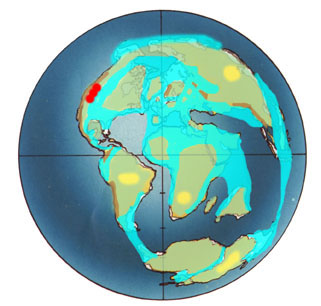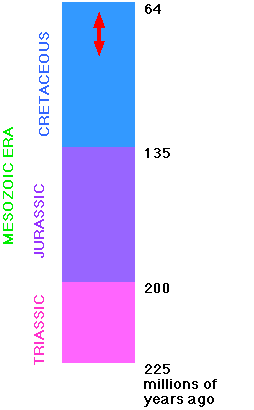|
|
 |
|

This map illustrates what the earth looked like in Cretaceous times about 65 millions years ago. The red dots indicate
where T.Rex lived.
Pronounced tie-RAN-o-SAWR-us rex
Named By - Henry Fairfield Osborn
When Named - 1905 |
| DIET: |
Carnivore (meat-eater) - T. rex ate large dinosaurs, like Triceratops |
| SIZE: |
Length - 40 feet (12.4 m) long
Height - 15 to 20 feet (4.6 to 6 m) tall
Weight
- 5 to 7 tons |
| WHEN IT LIVED: |
Late Cretaceous period, about 85-65 million years ago |
| WHERE IT LIVED: |
Fossil have been found in the USA (in Montana, Texas, Utah, and Wyoming), Canada (Alberta and Saskatchewan),
and east Asia (Mongolia). |
| FOSSILS: |
What was Found - About 30 incomplete T. rex fossils have been found. One T. rex footprint has been
found, in an undisclosed location in New Mexico, USA. Fossilized T.rex dung has also been found.
Who Found the Fossils - The first T. rex was first found by Barnum Brown in 1902.
Where
- The first T. rex was found in Hell Creek, Montana, USA, North America. |
| CLASSIFICATION: |
- Kingdom Animalia (animals)
- Phylum Chordata (having a hollow nerve chord ending in a brain)
- Class Archosauria (diapsids with socket-set teeth, etc.)
- Order Saurischia - lizard-hipped dinosaurs
- Suborder Theropoda - bipedal carnivores
- Tetanura - advanced theropods
- Infraorder Coelurosauria - lightly-built fast-running predators with hollow bones and large brains
- Superfamily Maniraptoriformes - advanced coelurosaurs with a fused wrist bone
- Family Tyrannosauroidea - huge predators with small arms and two-fingered hands (the third finger was very tiny).
Tyrannosaurids include T. rex, Albertosaurus, Alectrosaurus, Alioramus, Chingkankousaurus, Daspletosaurus, Eotyrannus, Gorgosaurus, Nanotyrannus, Prodeinodon, Tarbosaurus, etc.
- Genus Tyrannosaurus
- Species T. rex (type species named by Osborn, 1905)
|
INTERESTING
FACTS: |
Tyrannosaurus rex's arms were only about 3 feet (1 m) long, and it had 2-fingered hands. T. rex had cone-shaped,
serrated teeth that were continually replaced. |
| LINKS: |
A detailed page on T. rex.
More T. rex links. |

This time column of the Mesozoic Era shows when T.Rex was alive, in the late Cretaceous.
|
 |
|
THE tyrannosaurs were a group of large carnivorous dinosaurs that roamed North America and Asia during the last part of the Cretaceous, 85 to 65 million years ago. The most famous tyrannosaur,
of course, is Tyrannosaurus rex, known to every schoolchild, and one of the last non-avian dinosaurs to walk the earth
before the great extinction.
Just about two dozen good specimens of these animals have been found and these finds are from highly restricted areas in
western North America. Henry Fairfield Osborn, of the American Museum of Natural History in New York City, first described Tyrannosaurus rex in 1905. This first
specimen of Tyrannosaurus is now on display at the Carnegie Museum of Natural History in Pittsburgh, Pennsylvania. The skeleton on display at UCMP is a cast of a skeleton (excavated in 1990) now in the Museum
of the Rockies in Bozeman, Montana. Skeletons of a close relative of T. rex, Tarbosaurus, have been found in Mongolia.
Clearly this animal was imposing in size and stature. In fact, T. rex was one of the largest terrestrial carnivores
of all time. It stood approximately 15 feet high and was about 40 feet in length, roughly six tons in weight. In its large
mouth were six-inch long, sharp, serrated teeth. Good T. rex specimens, however, are hard to come by — Berkeley's
mount is 90% complete, one of the best specimens found to date. Some 15–20 other specimens around the country range
from about 10% to 80% complete; missing ribs and tail bones are common.
T. rex: Scavenger or Predator?
A current topic in paleontology that has received
much popular press is the question of whether T.rex (or other Tyrannosauridae in general) were predators or scavengers.
Let's explore this issue.
Paleontologist Jack Horner of the Museum of the Rockies (Bozeman, MT) has proposed that T.rex could not have been
a predator. His arguments against predation include its small eyes (needed to see prey), small arms (needed to hold prey),
huge legs (meaning slow speed) and that there is no evidence for predation — bones have been found with tyrannosaur
teeth embedded in them or scratched by them, but so far no study has shown that tyrannosaurs killed other dinosaurs for food
(a bone showing tyrannosaur tooth marks that had healed would be strong evidence for predation).
His evidence supporting scavenging include its large olfactory lobes (part of the brain used for smell), and that its legs
were built for walking long distances (the thigh was about the size of the calf, as in humans). Vultures have large olfactory
lobes and are good at soaring to cover long distances.
There are arguments against scavenging. Most large living predators (such as lions and hyenas) do scavenge meat happily
when it is available, but most do prefer fresh meat. Dr. Horner argues that its arms were too weak to grab prey, but sharks,
wolves, snakes, lizards and even many birds are successful predators without using their forelimbs (if any). Whether T.rex
was a slow animal is tough to tell, as our dinosaur speeds page will tell you.
What is the public to think of all this? It is suggested that you make up your own mind; the fact is that reconstructing
the behavior of extinct animals is difficult, especially when there are no close modern relatives with which to compare them.
Tyrannosaurs may have been scavengers, predators or both; Dr. Horner is merely presenting an opposing argument that shows
that we are not yet 100% sure what ecological niche the great tyrannosaurs filled.
At the present time only 13 finds of T.rex are Known.All of these are in Western North America.D uring the late
Cretaceous the North America continent was divided in two by an inland seaway. T.Rex lived in the Western portion of the continent
at that time.The fossil finds of this animal are located in Alberta, Canada and Montana, Wyoming, and South Dakota in the
USA. The sole track of this Dinosaur can be found by Los Alamos, New Mexico in the USA.
|
 |
|
|
 |
|
|
 |
|
|
|
|
largest, most complete, and best preserved T. rex fossil yet discovered.

The skeleton on display is the real thing. Not a plastic model or a plaster cast.
Not a patchwork or composite of bones from different specimens.
Sue stands 13 feet high at the hips and 42 feet long from head to tail. One of the
only pieces of Sue that is not mounted is her 5-foot-long skull, which is too heavy to be placed on the steel armature that
holds together her more than 200 fossilized bones. In its place, the Museum has installed a cast replica. Sue’s real
skull is on display in an exhibit on the second-floor balcony overlooking Stanley Field Hall. Here, visitors can get an up-close
view of the Sue’s massive head, as well as some insight into the mounting process and the story of how Sue ended up
at The Field Museum. In addition, visitors can view animated CT scans of the skull and touch a variety of casts of Sue’s
bones, including a rib, forelimb and tooth.
(© The Field Museum gn89671_53c)
 Although Sue spends every day in the public eye, she too has a private side. Sue’s bones are available for scientific
study to Field Museum researchers and visiting scientists from around the world. Although Sue spends every day in the public eye, she too has a private side. Sue’s bones are available for scientific
study to Field Museum researchers and visiting scientists from around the world.
The steel armature that holds Sue’s skeleton has been engineered so each bone is cradled in a hand-forged metal
bracket. These brackets are hinged and locked so each individual bone can be unlocked and removed for research, then returned
to its place. It is a unique solution to The Field Museum’s mission: to serve both science and the public. (© The Field
Museum GEO86584c)
|
|
|
 |

